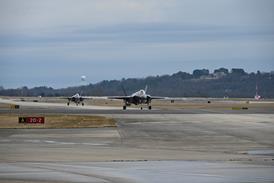The DA42 is a major development of Diamond's DA40 piston single. It uses the same wing sections for the outer panels, but they are finished at the tip with a pronounced 800mm (30in)-long tapering and near-vertical winglet. The cabin, from rear bulkhead to instrument panel, has the same dimensions as the DA40's and features the same forward-hinged clamshell canopy and side-opening (left side) cabin door for access to the rear seats. The rear fuselage has a similar T-tail, but with the addition of a fillet between the boom and fin and a dorsal fin of increased area.
Ailerons, rudder, elevator and wing flaps are constructed from a carbonfibre/glassfibre sandwich. Ailerons, elevator and flaps are operated via control rods, with cables for the rudder. All flight controls are manual, but the flaps are electrically driven and controlled by a three-position switch in the cockpit. "Simple flaps" span the first two-thirds of each outer wing panel and there are "split flaps" under the wing sections between the fuselage and engine nacelles. Elevator and rudder forces are trimmed via a cable-operated tab using separate trim wheels or, for the elevator, a double-pole trim switch on the control stick. The left-hand aileron has a fixed trim tab that can only be adjusted manually on the ground.
The undercarriage is hydraulically operated with spring assistance, and hydraulic pressure is provided by an electrical pump. The nosewheel retracts forwards and the main gear retracts inwards into the centre wing section, giving the DA42 a stable ground track of 3m (9.8ft).
Hydraulically powered disc brakes on the main wheels are individually operated using a toe pedal at the top of each respective rudder pedal. The parking brake is hydraulically operated by pumping the pedals and is controlled by a small lever on the centre console. Nosewheel steering uses the rudder pedals: as the gear retracts, the nosewheel is automatically centred and the steering disengaged.
The jet-fuel/diesel-cycle engines each develop 135hp (100kW) at a normal maximum propeller RPM of 2,300. The Centurion 1.7 has a common-rail direct-injection, liquid-cooled, four-cylinder in-line layout, with turbo-intercooler and 1:1.69 propeller reduction gear. Optional additional exhaust noise suppression can be fitted. Single-lever power controls set engine % load via the FADEC as well as setting the correct propeller RPM automatically. The two three-blade MTV-6 propellers are hydraulically regulated, variable-pitch, constant-speed and with autofeather protection if the engine fails when the propeller is above 1,100RPM. The blades are wood composite with a fibre-reinforced plastic coating and stainless-steel edge cladding.
Fuel is carried in three interconnected aluminium chambers in each wing, providing a total usable capacity of 190 litres (50USgal) of Jet A-1 fuel. Each tank group is filled through a large overwing filler cap close to each wing tip. The DA42 has a 28V DC electrical system with two 60A alternators and a 24V, 10Ah lead-acid battery. An emergency battery is fitted to power the standby instruments in the event of a total electrical failure in IFR.
Pitot-static values from a heated probe under the left wing are converted to digital signals by an air data computer for use by the Garmin G1000 displays. Navigation is based on GPS and VOR. Options include traffic collision alert system and Stormscope lightning detection. The G1000 also provides a full crew alerting system (CAS). Stall and gear up at low power audio warnings are provided.
There are large fresh-air vents either side of the main instrument panel. On the ground, the front canopy can be set slightly open to create a cooling gap. Small windows on either side of the canopy can also be opened. The cabin is heated and canopy defrosted using an engine radiator heat exchanger. There are two baggage compartments - one in the nose, with upward-hingeing doors either side, and one in the rear fuselage, accessible from the rear seats.
The seats, with additional Kevlar reinforcement, are stressed to 26g and Diamond says drop tests show the cabin is able to withstand or even exceed this level of crash impact without major deformation or damage.
Production aircraft will be fitted with the UK TKS anti-icing fluid system to protect the wing, tail and propellers against ice accretion. This was selected in preference to pneumatic boots or an electrically heated mat to reduce complexity and cost and to ensure the engine-driven electrical generator did not have to be modified from its present certificated and highly reliable status. The TKS system is cost-effective and uses small amounts of anti-icing fluid forced out of a porous membrane, on the protected leading edges, with about 600 microscopic laser-drilled holes per square centimetre.
Source: Flight International























